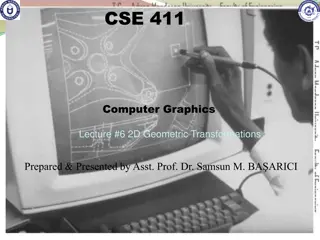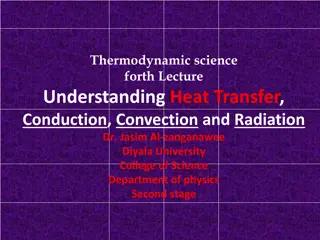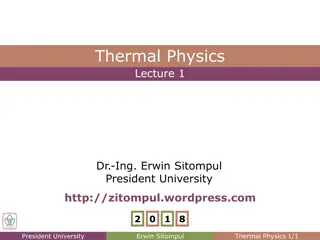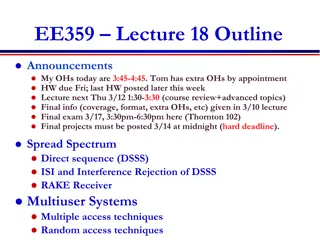
Modern DRAM Simulator Ramulator 2.0 Overview
Ramulator 2.0 is a modern, modular, and extensible DRAM and memory system simulator designed to address robustness and performance issues in DRAM technology. The simulator offers fine-grained modeling of DRAM operation at the cycle level, utilizing hierarchical state-machine-based modeling for unified functional and timing aspects. With a modular and extensible software architecture, Ramulator 2.0 can model a wide range of DRAM standards and memory controller functionalities, making it a valuable tool for various research studies in the field. Key features include simulation infrastructures for understanding and evaluating DRAM robustness and performance, performance overhead analysis, and support for emerging memory technologies.
Download Presentation

Please find below an Image/Link to download the presentation.
The content on the website is provided AS IS for your information and personal use only. It may not be sold, licensed, or shared on other websites without obtaining consent from the author. If you encounter any issues during the download, it is possible that the publisher has removed the file from their server.
You are allowed to download the files provided on this website for personal or commercial use, subject to the condition that they are used lawfully. All files are the property of their respective owners.
The content on the website is provided AS IS for your information and personal use only. It may not be sold, licensed, or shared on other websites without obtaining consent from the author.
E N D
Presentation Transcript
Ramulator 2 Presenter: Haocong Luo PhD Student, ETH Zurich SAFARI Research Group
Motivation Robustness issues in DRAM - Data retention - Read disturbance (RowHammer, RowPress, etc.) - Performance issues in main memory system - Performance overhead analysis of read disturbance mitigation techniques - Processing-in-Memory architectures - Emerging memory technologies - DRAM simulation infrastructures is needed to understand, characterize, and evaluate the robustness and performance of DRAM 2
Executive Summary Ramulator 2.0: Modern, modular, and extensible DRAM & memory system simulator Fine-grained modeling of DRAM operation (cycle-level) Unified functional and timing modeling of DRAM based on hierarchical state-machines Modular and extensible software architecture Models a wide range of DRAM standards and memory controller functionalities Used in a wide range of research works 3
Outline 1. Motivation 2. Ramulator 2.0 2.1 Simulator Design & Key Features 2.2 Case Studies 2.2.1 Cross-Sectional Study of RowHammer Mitigations 2.2.2 Evaluating the Performance of PRAC 2.2.3 BreakHammer: Throttling Suspect Threads 3. Conclusion & Future Work 4
Outline 1. Motivation 2. Ramulator 2.0 2.1 Simulator Design & Key Features 2.2 Case Studies 2.2.1 Cross-Sectional Study of RowHammer Mitigations 2.2.2 Evaluating the Performance of PRAC 2.2.3 BreakHammer: Throttling Suspect Threads 3. Conclusion & Future Work 5
Ramulator 2.0 Open-source version Github repo: CMU-SAFARI/ramulator2 IEEE CAL Paper 6
Outline 1. Motivation 2. Ramulator 2.0 2.1 Simulator Design & Key Features 2.2 Case Studies 2.2.1 Cross-Sectional Study of RowHammer Mitigations 2.2.2 Evaluating the Performance of PRAC 2.2.3 BreakHammer: Throttling Suspect Threads 3. Conclusion & Future Work 7
Ramulator 2.0 Design and Features (I) Hierarchical state-machine based modeling of DRAM Level: Channel Id: 0 State: State of a DRAM node: Current state: open, close, activating, etc. Timing constraints: Earliest time in the future that each DRAM command is allowed to be issued Energy & power: Time spent in each state and the number of DRAM commands served (DRAMPower model) Can be extended to include more Parent Sibling Level: Rank Id: 0 State: Level: Rank Id: 1 State: Children Level: BankGroup Id: 0 State: Level: BankGroup Id: 1 State: 8
Ramulator 2.0 Design and Features (II) DRAM commands implemented as lambda functions that hierarchically traverses and updates the states of the nodes 1. Checks the current states of the nodes to decode which DRAM command to issue 2. Programmatically apply state changes 3. Updates the timing constraints, power metrics, etc. Templated library of generalized DRAM command lambda functions allow reuse of command implementations across different DRAM standards Applicable to: DDR3, DDR4, DDR5 LPDDR4, LPDDR5 HBM (1/2/3), GDDR6 Example DRAM Command Decode Function 9
Ramulator 2.0 Design and Features (III) Modular and extensible software architecture - All components in the memory system modeled with the same interface and different implementations - Example: The memory controller include: Address Mapper, Request Scheduler, Refresh Controller, Row Policy, etc. Each can be flexibly changed without hardcoding other parts 10
Ramulator 2.0 Design and Features (IV) Modular and extensible software architecture - All components in the memory system modeled with the same interface and different implementations - Example: The memory controller include: Address Mapper, Request Scheduler, Refresh Controller, Row Policy, etc. Each can be flexibly changed without hardcoding other parts Example: Memory Controller Plugins 11
Ramulator 2.0 Design and Features (V) More in the paper - More detailed explanation of modeling methodology - Authoring of DRAM specifications (organization, timings, etc.) - Memory controller plugin & RowHammer mitigations - Performance comparison with other DRAM simulators - Open-source version Github repo: CMU-SAFARI/ramulator2 IEEE CAL Paper 12
Outline 1. Motivation 2. Ramulator 2.0 2.1 Simulator Design & Key Features 2.2 Case Studies 2.2.1 Cross-Sectional Study of RowHammer Mitigations 2.2.2 Evaluating the Performance of PRAC 2.2.3 BreakHammer: Throttling Suspect Threads 3. Conclusion & Future Work 13
Outline 1. Motivation 2. Ramulator 2.0 2.1 Simulator Design & Key Features 2.2 Case Studies 2.2.1 Cross-Sectional Study of RowHammer Mitigations 2.2.2 Evaluating the Performance of PRAC 2.2.3 BreakHammer: Throttling Suspect Threads 3. Conclusion & Future Work 14
Ramulator 2.0 Case Studies (I) Cross-section performance overhead evaluation of different RowHammer mitigation techniques [Luo+, IEEE CAL 2023] - Six different RowHammer mitigation techniques all implemented as plugins to the same memory controller implementation 15
Outline 1. Motivation 2. Ramulator 2.0 2.1 Simulator Design & Key Features 2.2 Case Studies 2.2.1 Cross-Sectional Study of RowHammer Mitigations 2.2.2 Evaluating the Performance of PRAC 2.2.3 BreakHammer: Throttling Suspect Threads 3. Conclusion & Future Work 16
Ramulator 2.0 Case Studies (II) New Read Disturbance Mitigation Features in DDR5 - RFM Command: New DRAM command that gives the memory controller a longer time window so that the DRAM can refresh potential victim rows - Per Row Activation Counting (PRAC): In-DRAM per-row activation counter (implemented as extra columns of cells) PRAC Workflow - Row activations increment the PRAC counters - If the counter value reaches a critical threshold, the DRAM send a back-off signal to the memory controller - Upon receiving the back-off signal, the memory controller send RFM commands to refresh the potential victim rows 17
Ramulator 2.0 Case Studies (III) Performance evaluation of DDR5 Per Row Activation Counting (PRAC) [Canpolat+, DRAMsec 24] - Memory controller implementation extended with support for per-row activation count tracking and back-off signal 18
Outline 1. Motivation 2. Ramulator 2.0 2.1 Simulator Design & Key Features 2.2 Case Studies 2.2.1 Cross-Sectional Study of RowHammer Mitigations 2.2.2 Evaluating the Performance of PRAC 2.2.3 BreakHammer: Throttling Suspect Threads 3. Conclusion & Future Work 19
Ramulator 2.0 Case Studies (IV) BreakHammer: Enhancing RowHammer Mitigations by Carefully Throttling Suspect Threads [Canpolat+, MICRO 24] - Goal: Reduce the performance overhead of RowHammer mitigation mechanisms by carefully reducing the number of performed RowHammer-preventive actions without compromising system robustness - Key Idea: Limit the dynamic memory request count of a hardware thread based on how frequently the thread triggers RowHammer-preventive actions 20
Ramulator 2.0 Case Studies (V) BreakHammer: Enhancing RowHammer Mitigations by Carefully Throttling Suspect Threads [Canpolat+, MICRO 24] - Key Mechanism: 1) Observe the triggered RowHammer preventive actions, 2) identify suspect threads, and 3) reduce the request count of the suspect threads 21
Ramulator 2.0 Case Studies (VI) BreakHammer: Enhancing RowHammer Mitigations by Carefully Throttling Suspect Threads [Canpolat+, MICRO 24] - BreakHammer s performance scaling for existin RowHammer mitigation mechanisms with an attacker present 22
Outline 1. Motivation 2. Ramulator 2.0 2.1 Simulator Design & Key Features 2.2 Case Studies 2.2.1 Cross-Sectional Study of RowHammer Mitigations 2.2.2 Evaluating the Performance of PRAC 2.2.3 BreakHammer: Throttling Suspect Threads 3. Conclusion & Future Work 23
Conclusion & Future Work Ramulator 2.0: Modern, modular, and extensible DRAM & memory system simulator Fine-grained modeling of DRAM operation (cycle-level) Models a wide range of DRAM standards and memory controller functionalities Used in a wide range of research works Ongoing & Future Works Unit & regression test coverage More DRAM standards and emerging technologies More detailed memory controller modeling (i.e., pipelined scheduler and gear ratio) Generalizable modeling for PuM/PnM architectures 24
DRAM Simulation and Testing Infrastructures Presenter: Haocong Luo Github repo: CMU-SAFARI/ramulator2 Ramulator 2 Paper











